
Features
Aggregates
Profiles
Recycle plant pays dividends for Lafarge
A portable crushing and screening spread has helped Lafarge Canada establish a successful business
August 6, 2010 By Andy Bateman
One of the challenges in producing aggregates from recycled concrete
and asphalt can be the variation in feed materials. Recycled concrete
in particular can vary considerably in size, rebar content, hardness,
and even colour.
One of the challenges in producing aggregates from recycled concrete and asphalt can be the variation in feed materials. Recycled concrete in particular can vary considerably in size, rebar content, hardness, and even colour. Milled asphalt is usually consistent, but broken asphalt may also contain varying quantities of granular material from the underlying roadbase. Depending on the source, both concrete and asphalt brought into recycle yards may also contain foreign material such as wood, metal and other debris, all of which has to be removed.
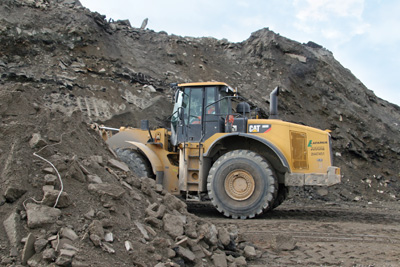 |
|
| In typical operation, a Caterpillar 980H wheel loader blends feed material from broken concrete and an asphalt /gravel pile.
|
A portable recycle setup operated by Lafarge in B.C.’s Lower Mainland has successfully tackled these issues and is also developing new products from recycled materials.
Kevin Tokarek, operations manager, GVA Aggregates, explains that the recycle spread and its support equipment moves regularly between company operations. A typical year for the three-year-old plant involves eight moves between the company’s Huntingdon, Coquitlam and Mitchell Island operations and 300,000 to 400,000 tonnes of production. Recent applications for the plant include the processing of concrete from the Old Pitt River Bridge into road base material, with this solution chosen in preference to ocean dumping, one of the other options on the table.
Aggregates & Roadbuilding saw the plant in action at Lafarge’s extensive recycling depot near Abbotsford. Depot manager Kevin Rowe notes that the materials received here include clean asphalt, broken concrete from various sources, as well as “dirty asphalt” containing a mixture of granular road base and asphalt. The recycle plant’s main product is 25 millimetre minus manufactured granular base, known locally as MGB. The MGB is produced from a blend of the asphalt/gravel mix and concrete, with the ratio of these feed materials adjusted to meet customer requirements. Customers include the Township of Langley, which uses the MGB extensively for road shouldering. In the Vancouver market, the popular recycled product has a significant manufacturing advantage compared to virgin material, as it avoids typical haulage costs of $5/tonne from the Fraser Valley aggregate pits.
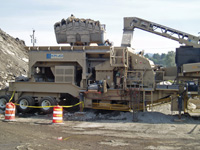
|
|
| An Andreas 4250 horizontal impact crusher fitted with Esco high chrome blow bars crushes the variable feed material. |
In normal operation, a John Deere 350DLC excavator fitted with an Allied BP 3042 pulverizer works in the concrete stockpile to sort feed material and remove rebar. This loosened feed is baled to the front of the concrete pile, where it is recovered by a Caterpillar 980H wheel loader. From there, the loader will typically carry the concrete feed across to the asphalt/gravel pile and mix the two materials in a one-to-one blend. The loader then dumps the mixture, about 10 tonnes per bucket, to the feed hopper of the KPI-JCI recycle plant. The hopper is fitted with grizzly bars that allow fines and smaller pieces of material up to about 125 mm to fall onto a conveyor below. At the same time, larger sizes are fed into the plant’s 4250 horizontal impact crusher, with crusher product falling onto the common conveyor. The combined stream then passes under an Industrial Magnets unit to remove rebar, while the material discharges onto the screen feed conveyor. The operator’s shack is mounted over the screen feed conveyor to allow hand picking and removal of any remaining rebar or debris. The material is then screened on a KPI-JCI 6 by 16 screen unit fitted with 37.5-mm opening cloths on the top deck and 25-mm opening cloths on the middle deck, with the bottom deck left open.
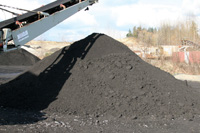 |
|
| : In a separate process at the Abbotsford yard, a Bandit Industries Beast 3580 recycler is used to manufacture modified shingle modifier (MSM) from roofing shingle tear-offs. MSM is added to stone mastic asphalt (SMA) mixtures to help prevent drain down of asphalt cement through the open graded aggregate matrix that is characteristic of SMA.
|
All material passing the bottom deck is stockpiled as 25 mm MGB while material retained on both screen decks is returned in closed circuit to the impactor for further reduction. Power for the stand-alone plant is provided by a Cummins engine driving both the impactor via belts and a generator set for the electric motors driving the screen and other conveyors. The plant operates with a crew of three on a two-shift daily pattern of 5 a.m. to 1 p.m. and 1 p.m. to 8 p.m. and achieves an average production rate of 200 tonnes-hour when producing MGB.
Readers familiar with asphalt and concrete recycling operations will know that the choice of blow bars used in an impact crusher can have a significant effect on overall plant productivity. Often there is a trade-off between bar hardness and wear resistance. Manganese bars with a low chrome content of about four per cent offer durability and resistance to breakage but wear relatively quickly when crushing concrete and so require more frequent changes. High chrome bars, on the other hand, having a chrome content of up to 25 per cent are effective when crushing concrete but, being more brittle, are susceptible to chipping and breakage until the hard edges are rounded off. Rowe seems to have found the best of both worlds, reporting good performance from Esco high chrome bars that are reducing concrete without requiring any initial rounding off.
Product development
Rowe is continually looking for ways both to improve the yield of existing products from the recycle feed materials and to develop new products. At the time of the visit, he was working on two interesting possibilities.
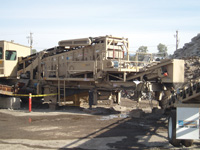
|
|
| This KPI-JCI 6 by 16 unit provides screening capacity on the portable spread.
|
The first project utilizes recycled concrete to produce 25-mm and 13-mm clear-sized coarse concrete aggregate. To date, these concrete aggregates have been produced on an experimental basis for use in new “green mix” concrete, and initial results are encouraging. One of the challenges is to maintain the consistency of the concrete aggregate, given the variations in feed material and this is achieved by separating the clean concrete in the feed stockpile. Based on initial conversations with the company’s quality control laboratory, applications for the “green” concrete mix will be limited to those requiring only relatively modest strengths of 20-25 megapascals such as residential basements and commercial applications. Nonetheless, these market segments consume large volumes of concrete and offer some promise for the future.
Rowe’s second project seeks to increase the recovery of asphalt rich material from the asphalt/gravel mixture. At present, potentially valuable pieces of asphalt are going into the MGB as “black rock” and not being recovered for use in hot-mix asphalt mixtures. In this case, the challenge is to effectively separate these asphalt lumps, typically sized at 25 mm and larger in the feed mixture, from the mostly 25-mm minus gravel. One possibility is to use the diverter gate underneath the KPI-JCI plant’s grizzly to provide an initial size cut of the material bypassing the impactor. With this in mind, a side discharge conveyor was installed at the primary plant ahead of the impactor. The gate allows some of the material falling through the tapered grizzly openings to be diverted out of the main product stream and onto the side conveyor. The quantity, size and type of material diverted is a function of the gate position and Rowe has experimented with the gate position to divert the most asphalt rich mixture onto the side conveyor. In a pilot test, the removed material was screened on a separate plant to complete the separation of asphalt lumps from gravel and any residual fines.
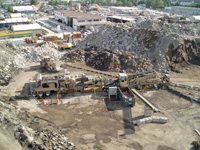 |
|
| At Lafarge’s Mitchell Island operation, the KPI-JCI recycle plant has successfully tackled variable concrete, asphalt and gravel feed materials.
|
According to the manufacturer, the two, three or four blow bar configurations offered by Andreas Series HSI Crushers offer the adaptability and capacity required to meet the fast-changing aggregate market. Their feed opening, MPR rotor and crushing chamber are said to make these impact crushers well suited for recycle and aggregate processing applications. Crusher capabilities include dual aprons that adjust independently to provide maximum application flexibility, innovative maximum production rotor (MPR) design, replaceable liners to protect the entire crushing chamber and blow bar options to meet specific application requirements. The 4250 impact crusher described here has a rated capacity of up to 272 tonnes-h, while larger units in the Andreas series provide crushing capacities of up to 410 tonnes-h.
Print this page